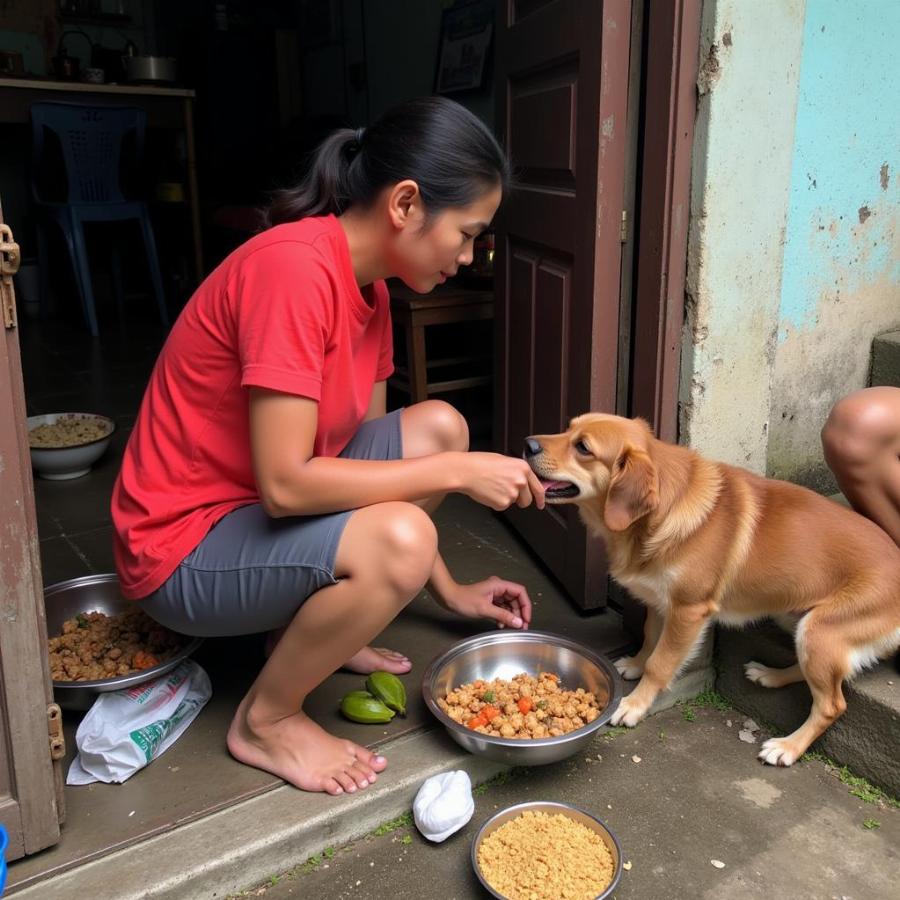Dogs play a significant role in Filipino culture, encompassing everything from beloved companions to culinary traditions. Understanding this multifaceted relationship requires looking beyond simple pet ownership and delving into the historical, social, and even economic impacts of “dog in Filipino” life. This article explores these diverse aspects, offering insight into how Filipinos perceive and interact with their canine counterparts.
The Many Faces of “Dog in Filipino” Society
Filipinos, known for their close-knit families, often extend this warmth to their pets, especially dogs. Dogs are commonly viewed as members of the family, providing companionship, security, and even playing a role in raising children. They are often given human names, included in family celebrations, and mourned deeply when they pass away. This deep connection goes beyond simple pet ownership and speaks to a cultural appreciation for the loyalty and affection that dogs offer. However, the concept of “dog in Filipino” culture isn’t without its complexities.
From Askals to Purebreds: Dog Breeds in the Philippines
While purebred dogs are gaining popularity, the ubiquitous Askal (Asong Kalye or street dog) holds a special place in Filipino hearts. These resilient mixed-breed dogs are known for their adaptability and loyalty. Many Filipinos choose to adopt Askals, seeing them as a symbol of Filipino resilience and resourcefulness. The rising interest in purebreds, however, also reflects a growing middle class and the influence of global trends. This blend of traditional appreciation for Askals alongside the adoption of foreign breeds creates a fascinating dynamic within the “dog in Filipino” landscape. Want to learn more about specific breeds? Check out our articles on allergy friendly dog food to understand dietary needs.
Caring for Your Dog, the Filipino Way
Nutritional Needs and Common Practices
 Chăm sóc chó kiểu Philippines
Chăm sóc chó kiểu Philippines
Feeding practices vary across the Philippines, influenced by both tradition and modern knowledge. While some owners still rely on table scraps, many are transitioning to commercially available dog food, understanding the importance of balanced nutrition. This shift reflects a growing awareness of canine health and wellbeing, fueled by readily available information and a desire to provide the best possible care for their furry companions. Have you considered a raw diet? Explore our guide on [feeding dogs raw diet how much to feed](https://beautdogs.com/feeding-dogs-raw-diet-how much-to-feed.html).
Dog Health in a Tropical Climate
Caring for a “dog in Filipino” weather presents unique challenges. The hot and humid climate can make dogs susceptible to heatstroke and parasitic infections. Regular grooming, preventative vet visits, and providing ample shade and fresh water are crucial. Understanding these climate-specific needs is essential for responsible dog ownership in the Philippines. Are you worried about your dog’s skin? We have an informative article on chicken skin for dogs.
The “Dog in Filipino” Cuisine: A Controversial Topic
The consumption of dog meat remains a sensitive and complex issue in the Philippines. While illegal in most areas, the practice persists in some regions, steeped in historical and cultural contexts. This aspect of “dog in Filipino” society often clashes with the growing movement for animal welfare and responsible pet ownership.
What is the general attitude towards dogs in the Philippines?
Filipinos generally have a positive and loving attitude towards dogs, often treating them as cherished members of the family.
Where can I find information on adopting a dog in the Philippines?
Numerous animal shelters and rescue organizations operate throughout the Philippines, dedicated to finding loving homes for dogs in need.
Are there specific laws regarding dog ownership in the Philippines?
Yes, the Philippines has laws in place concerning responsible pet ownership, including registration, vaccination, and leashing requirements.
Conclusion
The relationship between dogs and Filipinos is complex and multifaceted. From beloved family members to controversial culinary practices, “dog in Filipino” society reflects a blend of tradition, evolving attitudes, and the enduring bond between humans and their canine companions. Understanding this relationship is crucial for promoting responsible pet ownership and ensuring the wellbeing of dogs in the Philippines.
FAQ:
- What is the most common dog breed in the Philippines? The Askal (Asong Kalye) is the most commonly seen dog in the Philippines.
- Is it expensive to own a dog in the Philippines? The cost of dog ownership can vary depending on the breed, size, and health needs of the dog.
- Where can I find a veterinarian in the Philippines? Veterinary clinics are widely available in most cities and towns throughout the Philippines.
- Are there dog parks in the Philippines? Dog parks are becoming increasingly popular in urban areas of the Philippines.
- What are some common Filipino names for dogs? Common names include Bantay (Guard), Muning (Cat – often used ironically for dogs), and Brownie.
Explore More About Dogs:
Beaut Dogs is your trusted source for comprehensive and insightful information about the world of canine companions. We are passionate about providing valuable resources for dog lovers, covering everything from breed information to health and nutrition. For any assistance or further inquiries, please contact us via Email: [email protected]. We at Beaut Dogs are here to help you navigate the wonderful journey of dog ownership.